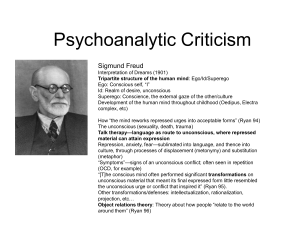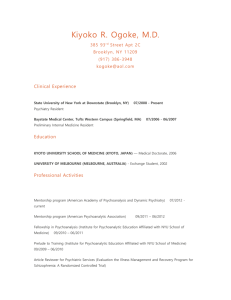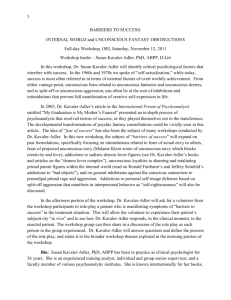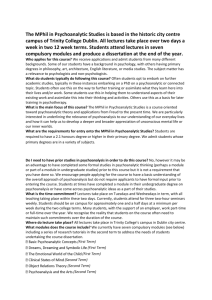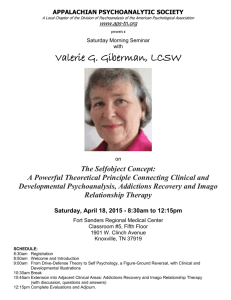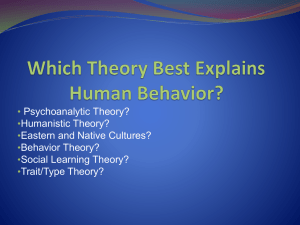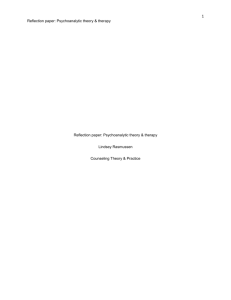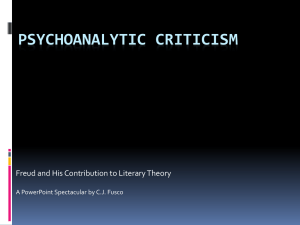Introduction to Psychoanalytic Criticism
advertisement
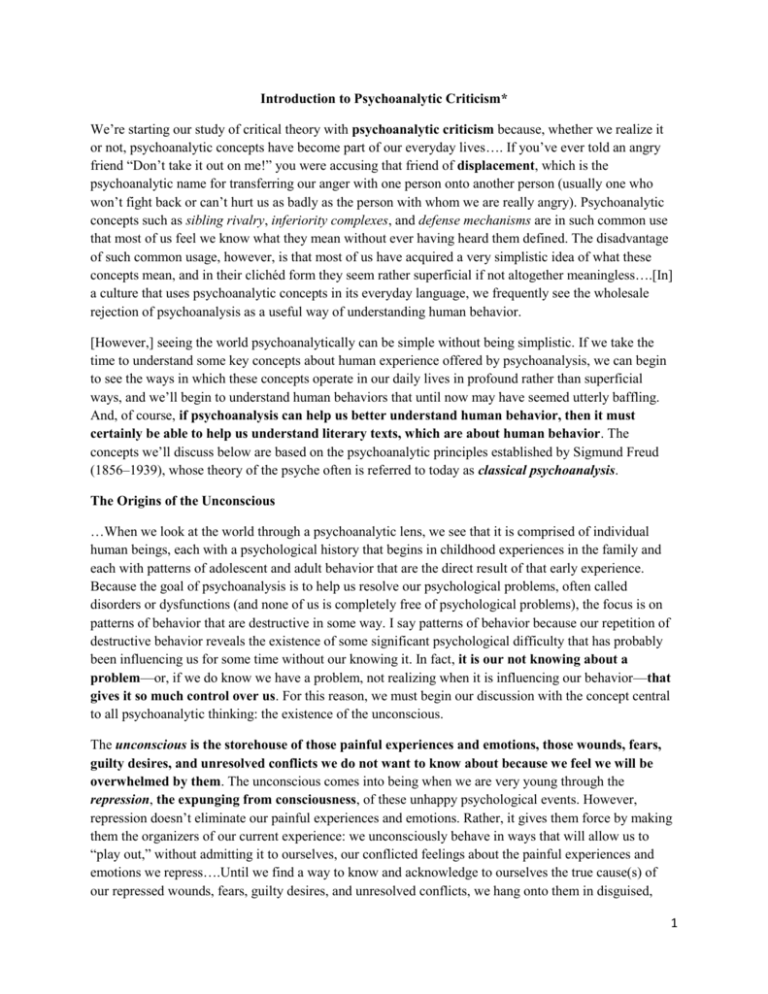
Introduction to Psychoanalytic Criticism* We’re starting our study of critical theory with psychoanalytic criticism because, whether we realize it or not, psychoanalytic concepts have become part of our everyday lives…. If you’ve ever told an angry friend “Don’t take it out on me!” you were accusing that friend of displacement, which is the psychoanalytic name for transferring our anger with one person onto another person (usually one who won’t fight back or can’t hurt us as badly as the person with whom we are really angry). Psychoanalytic concepts such as sibling rivalry, inferiority complexes, and defense mechanisms are in such common use that most of us feel we know what they mean without ever having heard them defined. The disadvantage of such common usage, however, is that most of us have acquired a very simplistic idea of what these concepts mean, and in their clichéd form they seem rather superficial if not altogether meaningless….[In] a culture that uses psychoanalytic concepts in its everyday language, we frequently see the wholesale rejection of psychoanalysis as a useful way of understanding human behavior. [However,] seeing the world psychoanalytically can be simple without being simplistic. If we take the time to understand some key concepts about human experience offered by psychoanalysis, we can begin to see the ways in which these concepts operate in our daily lives in profound rather than superficial ways, and we’ll begin to understand human behaviors that until now may have seemed utterly baffling. And, of course, if psychoanalysis can help us better understand human behavior, then it must certainly be able to help us understand literary texts, which are about human behavior. The concepts we’ll discuss below are based on the psychoanalytic principles established by Sigmund Freud (1856–1939), whose theory of the psyche often is referred to today as classical psychoanalysis. The Origins of the Unconscious …When we look at the world through a psychoanalytic lens, we see that it is comprised of individual human beings, each with a psychological history that begins in childhood experiences in the family and each with patterns of adolescent and adult behavior that are the direct result of that early experience. Because the goal of psychoanalysis is to help us resolve our psychological problems, often called disorders or dysfunctions (and none of us is completely free of psychological problems), the focus is on patterns of behavior that are destructive in some way. I say patterns of behavior because our repetition of destructive behavior reveals the existence of some significant psychological difficulty that has probably been influencing us for some time without our knowing it. In fact, it is our not knowing about a problem—or, if we do know we have a problem, not realizing when it is influencing our behavior—that gives it so much control over us. For this reason, we must begin our discussion with the concept central to all psychoanalytic thinking: the existence of the unconscious. The unconscious is the storehouse of those painful experiences and emotions, those wounds, fears, guilty desires, and unresolved conflicts we do not want to know about because we feel we will be overwhelmed by them. The unconscious comes into being when we are very young through the repression, the expunging from consciousness, of these unhappy psychological events. However, repression doesn’t eliminate our painful experiences and emotions. Rather, it gives them force by making them the organizers of our current experience: we unconsciously behave in ways that will allow us to “play out,” without admitting it to ourselves, our conflicted feelings about the painful experiences and emotions we repress….Until we find a way to know and acknowledge to ourselves the true cause(s) of our repressed wounds, fears, guilty desires, and unresolved conflicts, we hang onto them in disguised, 1 distorted, and self-defeating ways. For example, if I don’t realize that I still long for the love I never received from my long-dead, alcoholic father, I am very liable to select an alcoholic, aloof mate so that I can reenact my relationship with my father and “this time” make him love me. … In other words, I will experience my longing for my neglectful father as longing for my current heartthrob…. As you can see in the above example, the family is very important in psychoanalytic theory because we are each a product of the role we are given in the family-complex, for example, “I’m the failure”; “I’m the perfect child”; “I must always ‘come in second’ to my brother”; “I’m unlovable”; or “I’m responsible for my parents’ problems.” It is important to note that oedipal attachments, sibling rivalry, and the like are considered developmental stages. In other words, we all go through these experiences, and they are a natural and healthy part of maturing and establishing our own identities. It is when we fail to outgrow these conflicts that we have trouble. …The point is that, for both women and men, only by recognizing the psychological motivations for our destructive behavior can we hope to begin to change that behavior. The defenses, anxiety, and core issues Our unconscious desires not to recognize or change our destructive behaviors— because we have formed our identities around them and because we are afraid of what we will find if we examine them too closely—are served by our defenses. Defenses are the processes by which the contents of our unconscious are kept in the unconscious. In other words, they are the processes by which we keep the repressed repressed in order to avoid knowing what we feel we can’t handle knowing. Defenses include selective perception (hearing and seeing only what we feel we can handle), selective memory (modifying our memories so that we don’t feel overwhelmed by them or forgetting painful events entirely), denial (believing that the problem doesn’t exist or the unpleasant incident never happened), avoidance (staying away from people or situations that are liable to make us anxious by stirring up some unconscious—i.e., repressed—experience or emotion), displacement (“taking it out” on someone or something less threatening than the person who caused our fear, hurt, frustration, or anger), and projection (ascribing our fear, problem, or guilty desire to someone else and then condemning him or her for it, in order to deny that we have it ourselves). Perhaps one of the most complex defenses is regression, the temporary return to a former psychological state, which is not just imagined but relived. Regression can involve a return either to a painful or a pleasant experience. It is a defense because it carries our thoughts away from some present difficulty (as when Death of a Salesman’s Willy Loman flashes back to his past in order to avoid the unpleasant realities of his present life). However, it differs from other defenses in that it carries with it the opportunity for active reversal (i.e., healing), the acknowledgment and working through of repressed experiences and emotions, because we can alter the effects of a wound only when we relive the wounding experience. This is why regression is such a useful therapeutic tool…. Of course, sometimes our defenses momentarily break down, and this is when we experience anxiety. Anxiety can be an important experience because it can reveal our core issues. Some examples of the more common core issues: 2 Fear of intimacy—the chronic and overpowering feeling that emotional closeness will seriously hurt or destroy us and that we can remain emotionally safe only by remaining at an emotional distance from others at all times. Fear of abandonment—the unshakable belief that our friends and loved ones are going to desert us (physical abandonment) or don’t really care about us (emotional abandonment). Fear of betrayal—the nagging feeling that our friends and loved ones can’t be trusted, for example, can’t be trusted not to lie to us, not to laugh at us behind our backs, or in the case of romantic partners, not to cheat on us by dating others. Low self-esteem—the belief that we are less worthy than other people and, therefore, don’t deserve attention, love, or any other of life’s rewards. Indeed, we often believe that we deserve to be punished by life in some way. Insecure or unstable sense of self—the inability to sustain a feeling of personal identity, to sustain a sense of knowing ourselves. This core issue makes us very vulnerable to the influence of other people, and we may find ourselves continually changing the way we look or behave as we become involved with different individuals or groups. Oedipal fixation (or oedipal complex)—a dysfunctional bond with a parent of the opposite sex that we don’t outgrow in adulthood and that doesn’t allow us to develop mature relationships with our peers. The most important fact to remember is that core issues define our being in fundamental ways. They do not consist of occasional negative feelings, such as passing episodes of insecurity or low self-image. Having an occasional “bad-hair day,” for instance, does not indicate the presence of a core issue. Rather, core issues stay with us throughout life and, unless effectively addressed, they determine our behavior in destructive ways of which we are usually unaware. In other words, anxiety can tell us a good deal about ourselves because we are anxious in situations in which our core issues are in play. Psychoanalysis, as a form of therapy, is the controlled working in and with anxiety. Its goal…isn’t to strengthen our defenses or restore us to social adaptation but to break down our defenses in order to effect basic changes in the structures of our personality and the ways we act. Dreams and dream symbols When we sleep, it is believed that our defenses do not operate in the same manner they do when we are awake. During sleep, the unconscious is free to express itself, and it does so in our dreams. However, even in our dreams there is some censorship, some protection against frightening insights into our repressed experiences and emotions, and that protection takes the form of dream distortion. The “message” our unconscious expresses in our dreams, which is the dream’s underlying meaning…is altered so that we don’t readily recognize it through processes called displacement and condensation. Dream displacement occurs whenever we use a “safe” person, event, or object as a “stand-in” to represent a more threatening person, event, or object. For example, I might dream that my teacher gave me an F on a paper that I put a lot of effort into, but that might actually stem from (real or perceived) my parents’ disappointment in or disapproval of me. Condensation occurs during a dream whenever we use a single dream image or event to represent more than one unconscious wound or conflict. For example, my 3 dream that I’m battling a ferocious bear might represent psychological “battles” or conflicts both at home and at work. Certain general principles of dream interpretation tend to apply in most cases, and they are as follows. Because dreamers create all the “characters” in their dreams, there is a real sense in which each person we dream about is really a part of our own psychological experience that we project during the dream onto a stand-in. If I dream that my sister gives birth to a stillborn child, for example, I might be dreaming either that I have “given birth to a stillborn child” (a failed relationship? a failed career? a failed artistic endeavor?) or that I am “a stillborn child” (am I feeling abandoned? helpless? depressed?). As this example makes evident, dreams about children almost always reveal something about our feelings toward ourselves or toward the child that is still within us and that is probably still wounded in some way. *** Classical psychoanalysis and literature Our job, when we read psychoanalytically, is to see which concepts are operating in the text in such a way as to enrich our understanding of the work and, if we plan to write a paper about it, to yield a meaningful, coherent psychoanalytic interpretation. …Some critics have objected to the use of psychoanalysis to understand the behavior of literary characters because literary characters are not real people and, therefore, do not have psyches that can be analyzed. However, psychoanalyzing the behavior of literary characters is probably the best way to learn how to use the theory. Furthermore…when we psychoanalyze literary characters, we are not suggesting that they are real people but that they represent the psychological experience of human beings in general. …This might be a good place to pause and answer a frequently asked question concerning psychoanalytic readings of literary works: if we find psychoanalytic concepts operating in a literary text, does it mean that the author has deliberately put them there, and how can an author put them there if he or she lived before Freud or never heard of him? The answer is simple: Freud didn’t invent psychoanalytic principles; he discovered them operating in human beings. In other words, Freud named and explained principles of human behavior that were present long before he found them and that would be present even if he didn’t describe them. So any literary text that accurately describes human behavior or that is the product of an author’s unconscious (which we presume all creative works are to some extent) will include psychoanalytic principles whether or not the author had any awareness of those principles when writing the work. For psychoanalysis, literature, and indeed all art forms, are largely products of unconscious forces at work in the author, in the reader, or, for some contemporary psychoanalytic critics, in our society as a whole….Any human production that involves images, that seems to have narrative content (the way many paintings seem to tell a story), or that relates to the psychology of those who produce or use it (which means just about everything!) can be interpreted using psychoanalytic tools. *This essay has been excerpted. The complete article can be found at: Professor Mitch’s English Comp Courses. “Psychoanalytic Criticism.” (9/25/15) URL: https://profmitch.files.wordpress.com/2013/08/tyson_chap02.pdf (January 2010). 4

